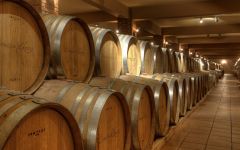Skouras Moscofilero 2021
-
Robert
Parker -
Wine
Enthusiast



Product Details
Your Rating
Somm Note
Winemaker Notes
The color is light white yellow. Opulent aromas –light and fresh– of white flowers and honeysuckle are revealed, rounded out with notes of citrus fruits and lime. Medium- to full-bodied, refreshing and vigorous acidity, with the aromas on the mouth following those of the nose. Elegant, balanced and with a long finish.
Professional Ratings
-
Robert Parker's Wine Advocate
The 2021 Moscofilero (in the Skouras transliteration) comes in with 4.5 grams of residual sugar, 6.4 of total acidity and 12.2% alcohol. This is sourced from vines at 650 meters in altitude. A kinder and gentler wine than the Salto in this report, this foregoes the acidic zing in favor of a rounder feel and easier balance between acidity and residual sugar. That makes this seem more full-bodied in perception, less silky and less tense. If at times that also makes this one a little simpler, less individualistic and less energetic, it is more likely to be the crowd-pleaser in style. I thought it was a bit too simple on opening. Trying it the next day brought out its structure, though, and made it far more lively and aromatic as well. Drink this now or in the next couple of years for best results and give the Salto another six to 12 months in the cellar. Both wines will make you happy in their own way.
-
Wine Enthusiast
Delicately floral notes offset the ripe pineapple and subtle sage aromas on this light-bodied Moscofilero from Skouras, named for groundbreaking winemaker (and Peloponnesian hometown hero) George Skouras. Fermented in stainless steel, the wine saw the briefest contact with its skins before sitting on its lees, and there’s ample acidity and a bit of salinity on the refreshing palate.
Other Vintages
2022-
Robert
Parker
-
Robert
Parker
-
Robert
Parker
-
Wine &
Spirits -
Robert
Parker - Decanter
-
Robert
Parker
-
Robert
Parker
-
Robert
Parker
-
Robert
Parker -
Wine
Spectator
-
Robert
Parker -
Wine &
Spirits
-
Wine
Spectator

A pink-skinned variety from the Peloponnese, Greek Moschofilero produces a delicatly perfumed, fresh white wine. There on the Mantineia plateau, the cool growing conditions allow ample time for the grapes to develop balanced sugars and aromatics. Moschofilero is actually the most popular of many mutations of the ancient Fileri grape. These range in color from white to red and produce an array of styles including fruity pink and sparkling versions. Somm Secret—If you already love Muscat, definitely try Moschofilero. Though the grapes are unrelated, they produce remarkably similar wines.

A large southern region of Greece, the Peloponnese contains the famous appellations of Nemea and Mantineia. While connected to the mainland by a tiny strip of land, essentially the region is a large Mediterranean island and excels in the production of red wine from Agiorghitiko, white from Moscofilero and sweet wine from the Mavrodaphne grape.





